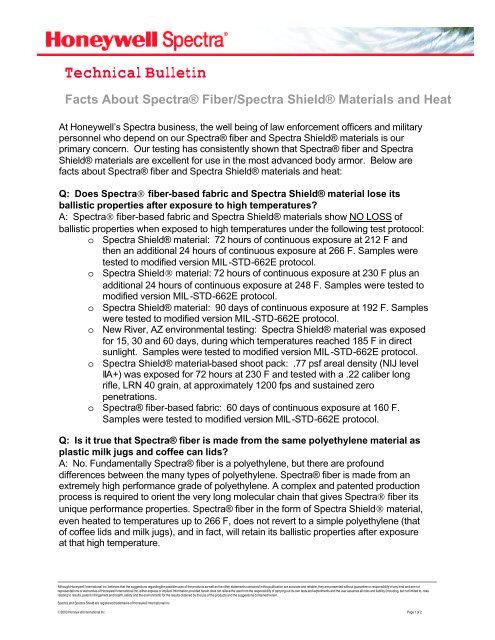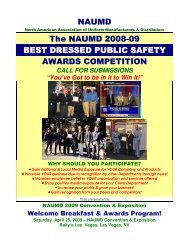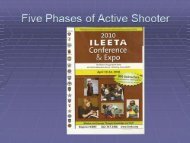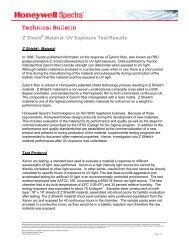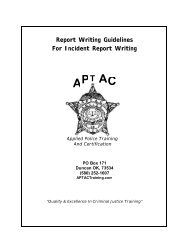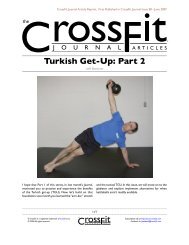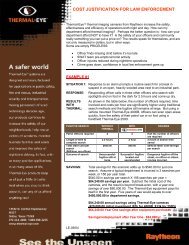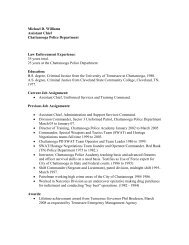Technical Bulletin - Facts About Spectra® Fiber/Spectra Shield ...
Technical Bulletin - Facts About Spectra® Fiber/Spectra Shield ...
Technical Bulletin - Facts About Spectra® Fiber/Spectra Shield ...
You also want an ePaper? Increase the reach of your titles
YUMPU automatically turns print PDFs into web optimized ePapers that Google loves.
<strong>Technical</strong> <strong>Bulletin</strong><br />
<strong>Facts</strong> <strong>About</strong> <strong>Spectra</strong>® <strong>Fiber</strong>/<strong>Spectra</strong> <strong>Shield</strong>® Materials and Heat<br />
At Honeywell’s <strong>Spectra</strong> business, the well being of law enforcement officers and military<br />
personnel who depend on our <strong>Spectra</strong>® fiber and <strong>Spectra</strong> <strong>Shield</strong>® materials is our<br />
primary concern. Our testing has consistently shown that <strong>Spectra</strong>® fiber and <strong>Spectra</strong><br />
<strong>Shield</strong>® materials are excellent for use in the most advanced body armor. Below are<br />
facts about <strong>Spectra</strong>® fiber and <strong>Spectra</strong> <strong>Shield</strong>® materials and heat:<br />
Q: Does <strong>Spectra</strong> fiber-based fabric and <strong>Spectra</strong> <strong>Shield</strong>® material lose its<br />
ballistic properties after exposure to high temperatures?<br />
A: <strong>Spectra</strong>® fiber-based fabric and <strong>Spectra</strong> <strong>Shield</strong>® materials show NO LOSS of<br />
ballistic properties when exposed to high temperatures under the following test protocol:<br />
o <strong>Spectra</strong> <strong>Shield</strong>® material: 72 hours of continuous exposure at 212 F and<br />
then an additional 24 hours of continuous exposure at 266 F. Samples were<br />
tested to modified version MIL-STD-662E protocol.<br />
o <strong>Spectra</strong> <strong>Shield</strong>® material: 72 hours of continuous exposure at 230 F plus an<br />
additional 24 hours of continuous exposure at 248 F. Samples were tested to<br />
modified version MIL-STD-662E protocol.<br />
o <strong>Spectra</strong> <strong>Shield</strong>® material: 90 days of continuous exposure at 192 F. Samples<br />
were tested to modified version MIL-STD-662E protocol.<br />
o New River, AZ environmental testing: <strong>Spectra</strong> <strong>Shield</strong>® material was exposed<br />
for 15, 30 and 60 days, during which temperatures reached 185 F in direct<br />
sunlight. Samples were tested to modified version MIL-STD-662E protocol.<br />
o <strong>Spectra</strong> <strong>Shield</strong>® material-based shoot pack: .77 psf areal density (NIJ level<br />
IIA+) was exposed for 72 hours at 230 F and tested with a .22 caliber long<br />
rifle, LRN 40 grain, at approximately 1200 fps and sustained zero<br />
penetrations.<br />
o <strong>Spectra</strong>® fiber-based fabric: 60 days of continuous exposure at 160 F.<br />
Samples were tested to modified version MIL-STD-662E protocol.<br />
Q: Is it true that <strong>Spectra</strong>® fiber is made from the same polyethylene material as<br />
plastic milk jugs and coffee can lids?<br />
A: No. Fundamentally <strong>Spectra</strong>® fiber is a polyethylene, but there are profound<br />
differences between the many types of polyethylene. <strong>Spectra</strong>® fiber is made from an<br />
extremely high performance grade of polyethylene. A complex and patented production<br />
process is required to orient the very long molecular chain that gives <strong>Spectra</strong>® fiber its<br />
unique performance properties. <strong>Spectra</strong>® fiber in the form of <strong>Spectra</strong> <strong>Shield</strong>® material,<br />
even heated to temperatures up to 266 F, does not revert to a simple polyethylene (that<br />
of coffee lids and milk jugs), and in fact, will retain its ballistic properties after exposure<br />
at that high temperature.<br />
Although Honeywell International Inc. believes that the suggestions regarding the possible uses of the products as well as the other statements contained in this publication are accurate and reliable, they are presented without guarantee or responsibility of any kind and are not<br />
representations or warranties of Honeywell International Inc, either express or implied. Information provided herein does not relieve the user from the responsibility of carrying out its own tests and experiments and the user assumes all risks and liability (including, but not limited to, risks<br />
relating to results, patent infringement and health, safety and the environment) for the results obtained by the use of the products and the suggestions contained herein.<br />
<strong>Spectra</strong> and <strong>Spectra</strong> <strong>Shield</strong> are registered trademarks of Honeywell International Inc.<br />
©2003 Honeyw ell In ternational Inc. Page 1 of 2
Q: What happens to <strong>Spectra</strong> fiber and <strong>Spectra</strong> <strong>Shield</strong> materials in the event of<br />
a coffee spill?<br />
A: In a test, 96 oz of coffee at a temperature of 178.8 F was poured directly on <strong>Spectra</strong><br />
<strong>Shield</strong>® ballistic material. This material was tested immediately after contact. There was<br />
NO LOSS of ballistic performance. In a real-life situation involving a vest, coffee would<br />
first come in contact with air, then the outer carrier of the vest garment and then the<br />
ballistic carrier that protects the multi-layer ballistic package – cooling to a temperature<br />
far below any that would compromise the panel’s ballistic integrity. Also, <strong>Spectra</strong>® fiber<br />
is resistant to water and has a significantly higher resistance to many chemicals than<br />
most other high performance fibers currently used in soft body armor.<br />
Q: What happens to <strong>Spectra</strong> fiber and <strong>Spectra</strong> <strong>Shield</strong> materials inside a<br />
ballistic resistant vest in the event of fire exposure?<br />
A: Multiple tests have been conducted at different accredited laboratories specializing<br />
in the testing of flame resistant clothing. The tests were designed to simulate fire<br />
conditions that would not require specialized heat protective clothing. In all cases the<br />
<strong>Spectra</strong> <strong>Shield</strong>® materials were virtually unaffected by heat and flame. The conclusion<br />
was that vests designed for the anticipated fire conditions and containing <strong>Spectra</strong>®<br />
fiber-based materials did not increase the wearer’s risk from fire.<br />
These are examples of the kind of comprehensive testing that has been done around<br />
<strong>Spectra</strong> <strong>Shield</strong>® materials and <strong>Spectra</strong>® fiber-based fabrics. Our mission is to help<br />
protect law enforcement and military personnel through the development of advanced<br />
materials. We take that commitment very seriously.<br />
For more information about Honeywell’s ballistic materials, please visit our Web site:<br />
www.spectrafiber.com, where you can also find information about our partnership with<br />
the National Tactical Officers Association (NTOA) and the Safe Today, Alive Tomorrow<br />
safety awareness program.<br />
For more information, please contact:<br />
Toll Free: +1-800-695-5969<br />
Europe: +33 3 82 44 80 00<br />
Asia: +662 631 1969<br />
Web site: www.spectrafiber.com<br />
Although Honeywell International Inc. believes that the suggestions regarding the possible uses of the products as well as the other statements contained in this publication are accurate and reliable, they are presented without guarantee or responsibility of any kind and are not<br />
representations or warranties of Honeywell International Inc, either express or implied. Information provided herein does not relieve the user from the responsibility of carrying out its own tests and experiments and the user assumes all risks and liability (including, but not limited to, risks<br />
relating to results, patent infringement and health, safety and the environment) for the results obtained by the use of the products and the suggestions contained herein.<br />
<strong>Spectra</strong> and <strong>Spectra</strong> <strong>Shield</strong> are registered trademarks of Honeywell Inte rnational Inc.<br />
©2003 Honeywell International Inc. Page 2 of 2


